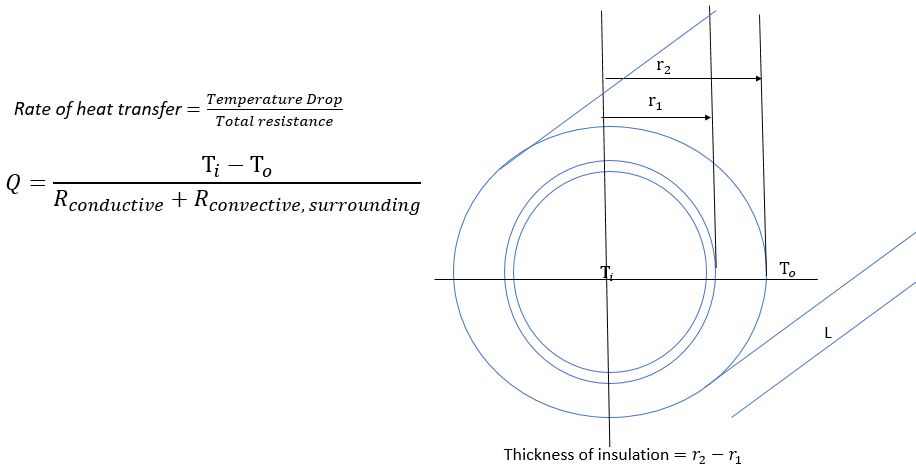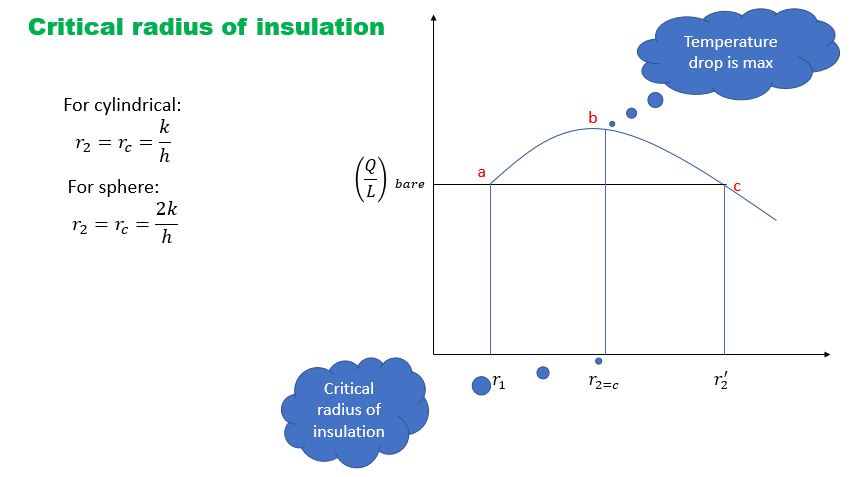Critical thickness of insulation or Critical radius of insulation: The critical radius of insulation is the point where overall resistance is lowest and heat loss is highest on a curved surface.
I would be taking you through a concept that can strengthen your knowledge and love of Heat transfer.
What is critical radius of Insulation?
As its name suggests Critical thickness of insulation/Critical radius of insulation is the thickness that gives us an idea about the amount of insulation required for Heat transferring equipment beyond which rate of heat transfer through the equipment’s wall decrease with the addition of the insulation.
Why to study Critical thickness or radius of insulation ?
I am preassuming that you have basic knowledge of Heat transfer governing laws. If not, don’t worry, just comment below I’ll be happy to explain that also in detail.
An engineer’s job is not only limited to applying science to make things better in this world, it’s more about applying science in an optimized way. As you know different Thermal insulations have different thermal conductivity values and lower the thermal conductivity less wastage of heat energy.
While selecting Insulation materials one should always keep the costing factor in mind.
let’s understand the concept with a practical problem
Example for Critical radius of insulation
Let’s consider a steam pipe (steam inside the pipe) having a negligible wall thickness.

Let’s do an activity, assuming you are visualizing the same problem where steam is flowing inside a cylindrical pipe that is being insulated with insulation having thermal conductivity ‘K’. Ideally, For the same Temperature drop if Resistance increases Heat transfer from pipe to the surrounding must be reduced but in the case of cylinder and sphere where applying insulation, R conductive increases but at the same time R convective decreases. Going forward with increasing insulation, There a condition arrives where overall resistance becomes minimum and Heat loss becomes maximum, and the corresponding radius of insulation is known as the critical radius of insulation.
Critical radius of insulation for cylinder and sphere
There is a numerical relation between Critical radius of insulation of Cylinder and sphere, if both are made up of same material, have same thermal conductivity ‘k‘ and heat transfer coefficient ‘h‘. Critical radius of insulation for a sphere is 2 times the critical radius of insulation of that cylinder.
Formulae for both Cylinder and sphere are mentioned below in the picture.

Up to the Critical radius of insulation, Heat transfer(loss of heat) from inside to the surrounding increases. Once critical insulation is achieved the Heat loss started to decrease on the application of additional insulation because Total overall resistance started increasing after critical insulation of thickness.
At a critical radius of insulation heat transfer rate is maximum from pipe wall to surrounding and thereafter it decreases on the addition of insulation.
Critical radius of insulation-FAQs
Critical thickness of insulation comes only in case of variable area problems like cylinder and sphere where the area of heat transfer changes upon addition of insulation.
The Critical radius of insulation can only be found when adding insulation area for Heat transfer changes. As mentioned an example of critical radius for hollow cylinder in this article.
As you can do unit balance using the formula mentioned, the units of critical radius of insulation come out to be a meter (m).
Critical thickness of insulation is significant to understand a length up to which rate of heat transfer through the equipment is maximum and if add more layers of insulation heat transfer through the equipment wall starts to decrease. It gives us a theoretical value basis that we can suggest an optimum thickness of insulation.
The rate of heat transfer from the pipe walls starts decreasing because at a critical thickness of insulation rate of heat transfer through pipe shows its maxima.
(r=k/h) is the formula for Cylindrical critical thickness of insulation where as (r=2k/h) is for sphere which is 2x of cylinder of same kind.
i have a small doubt on critical radius of insulation topic
1. if heat loss is maximum at critical radius of insulation then why should we use that radius instead of going beyond the critical radius of insulation?
2. in practical heat loss to surroundings is maximum for bare pipe compared to insulated pipe
Hi Karthik
Please find below answers to your queries:
1. Critical radius of insulation suggests a value of thickness that is required as an insulation after which heat loss will decrease. it helps us in understanding minimum amount of insulation required. We should use amount of insulation more than critical radius of insulation. That radius is just an indication to choose insulation quantity basis our energy saving target.
2. In general it is the case. But, This Heat loss increases further if applied insulation thickness is less than critical thickness of insulation.
We hope, We have helped you with your doubts. If you still have any doubts. feel free to put your thoughts.
Happy to help 🙂